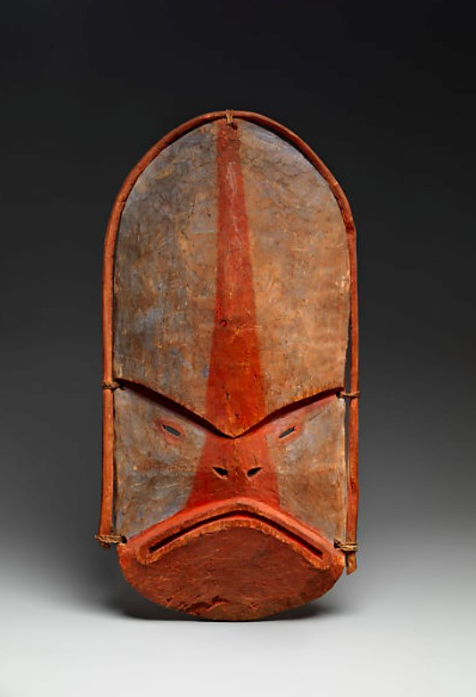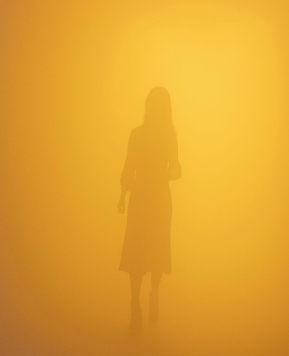Between The Wars: The Bauhaus And The Avant-Garde
By Anneka Scholtz. Art History 222: Radical Transformations. Semester Two, 2018. Grade: A
What effect did war in Europe have on the Bauhaus? Discuss this in relation to other influences and ideas relating to the Bauhaus. Refer to artworks across the range of design, painting, sculpture and architecture.
Between two world wars, the Bauhaus school of art (1919-1933) emerged as a product of, and a reaction to, a chaotic period of political and social upheaval in Germany post-World War I. Signifying a break with traditional salon art, the utopian ideals of the Bauhaus aimed to address the problems of industrialisation in a rapidly changing social climate, and raise fine art and craft to equal status. The Bauhaus school was highly progressive and avant-garde, embracing “architecture and sculpture and painting in one unity which will one day rise toward heaven from the hands of a million workers like the crystal symbol of a new faith”.[1]
The Armistice which ended World War I left Germany devastated. It was bankrupted by the reparations it was forced to make to the victorious countries. The rule of the Kaiser and the nobility had ended, class structures were destroyed, and millions of men killed, leading to a period of political turmoil. Simultaneously, the Revolution in neighbouring Russia was increasingly spreading ideas of Communism into Germany. As the poverty-stricken Weimar Republic emerged from the demise of the German Empire, artists such as Walter Gropius saw a world traumatised by the horrors of war, and could no longer accept the ornamentation and elitism of traditional art and bourgeois culture associated with the past.[2]
Founding the Bauhaus school in 1919 in Weimar, Germany, Gropius intended to unify the visual arts as one “great structure”, through workshop instruction and a return to trade skills and collaboration.[3] The Bauhaus style consisted of functional objects and works for modern life and everyday people, and was characterised by geometric forms, primary colours and simplicity.[4] Architecture, design, painting and sculpture were explored in novel ways by artists of the movement, who investigated technological principles of utility and rationality as a logical conclusion for art in the face of such a tumultuous and alienating period. Such principles also seemed necessary due to the lack of resources after the war; function and affordability remained the only features of importance to them.
The revolutionary tone set by the Bauhaus Manifesto inextricably linked the school with Communism and the growing political atmosphere in Germany. Many of the students and even staff were Communists.[5] Ideas of “a new faith” and “structure of the future” later set them in direct conflict with the aims of the Nazi party, whose power was threatened by these ideals.[6] The school remained highly provocative throughout its existence and shifting locations. The once revolutionary school was progressively stifled by the Nazi regime, ultimately meeting its fate with the onset of the Second World War.[7] The same forces drove many key Bauhaus figures from Germany, some seeking refuge in other European countries, but many fleeing to the United States. This had the effect of spreading the Bauhaus approach internationally, creating a legacy of Modernism that endures today.
The break from traditional art executed by the Bauhaus was not a novel concept. Many modernist art movements, such as German Expressionism, saw traditional art as no longer meeting the needs of an increasingly industrialised society.[8] The devastation caused by World War I called for a fresh start in art, characterised by experimentation, a return to basic forms and an embracing of the machine through a new, universal language of design.[9] Such experimentation, as embodied by the Bauhaus, mirrored post-war society in its burgeoning modernity and technological advancement.
In the ideologically utopian beginnings of the Bauhaus, Gropius stated in his Manifesto that “the ultimate aim of all visual arts is the complete building!”.[10] Architecture was important for the Bauhaus as it exemplified the goal for functional art and craft. Modernist architecture often celebrated the rationality of industrial technology, despite technology’s part in the destruction and violence of war. Perhaps in the eyes of the Bauhaus artists there was no choice but to embrace industrialisation and create a life-giving force from the darkness of the time. Similarly, Bauhaus architecture became interested in an architecture for the people, designing industrially manufactured, affordable housing for a country struck by economic crisis following the World War I.[11]
The Haus am Horn (1923), designed by Bauhaus teacher Georg Muche, was a small-scale, flat-roofed, modern villa, designed for a small working class family with no servants (see figures 1 and 2).[12] Constructed from prefabricated parts and furnished entirely by the Bauhaus workshops, the house was an experiment in low-cost housing that was economic to build and run at a time when resources were scarce and efficiency was therefore necessary.[13] The house used industrial materials such as steel and concrete, in a simple, geometric design, with a correspondingly pared-back colour palette and interior. Its design reflected a desire to embrace modern life which called for modern materials. Although the house was very well-crafted and thoughtfully built, the design fundamentally leant itself to mass-production. Like most Bauhaus architecture, the innovative dwelling was minimalist in form and decoration, reflecting the order and rationality characteristic of Bauhaus style.
Like the Bauhaus approach to architecture, design of objects, furniture and textiles was founded on the development of functional objects for modern domestic life. This ‘new design’ entailed the rejection of traditional ornamentation of objects which, according to Marcel Breuer, had no purpose.[14] Furniture, for example, needed to be lightweight and versatile, suitable for industrial production for the masses. Breuer’s Wassily Chair (1925), named after Kandinsky and inspired by De Stijl principles, reduced the classic club chair to its fundamental frame (see figure 3). Constructed from tubular steel, an innovative and lightweight industrial material, the chair retained its core function whilst still appearing sleek and elegant through its simplicity.[15] Artists such as Breuer succeeded in creating practical household objects for the mass consumer but remaining in line with the ultimate Bauhaus goal of a return to workmanship, through experimentation and exploration of the limits of art and design. The geometric, simplified chair demonstrates the dedication of the Bauhaus to aesthetics and extending these to the broader everyday world.[16] Unlike the ostentatious, bourgeois furniture of the past, Bauhaus objects could be elegant, modern and affordable for the average German home.
The fundamental aims of the Bauhaus meant more focus on design, manufacture and exploration of forms not previously investigated in traditional art. Therefore, painting was less employed by the school as a means of craft for modern life and was considered more of a personal indulgence, only entering the curriculum in its later years.[17] Nevertheless, the Bauhaus masters included several prominent modernist painters, such as Paul Klee, Wassily Kandinsky and Josef Albers. Although diverse in their practice, the painters at the Bauhaus were interested by elementary form and colour, often approaching these systematically.[18] Artists such as the Futurists and Constructivists had explored the dynamism of modern life and rejected traditional painting in a similar way to those of the Bauhaus. However, Bauhaus masters such as Josef Albers represented an extremely experimental and modern approach to form and colour that further revolutionised abstraction in art. Albers’ Homage to the Square: Against Deep Blue (1955) consists of 3 differently coloured squares of pure, primary colour, progressively smaller and positioned within each other (see figure 4).[19] The squares of colour are flat and evenly painted, drawing attention to the interaction of colour and its optical effects. The work experimental and simplified in form and colour, questioning whether three-dimensional forms can be explored through colour relationships. This reduction of painting and form to an analytical perspective reflects the Bauhaus interest in reducing forms to their essential units.[20]
An exploration of form and geometry was often most aptly executed through the medium of sculpture. Sculpture at the Bauhaus corresponded directly to craft, often executed in stone and wood carving. Students explored the possibilities of abstraction and spatial relationships in three-dimensional forms.[21] Unlike object design, sculpture was not necessarily functional, but highly experimental and often interested in technology and new materials. Form master László Maholy-Nagy believed in the push toward mass-production for the Bauhaus and encouraged experimentation in lighting and industrial materials such as metal and glass, that had rarely been explored as materials in art. This interest in new media ultimately lead to Maholy-Nagy’s creation of Light Prop for an Electric Stage (1929-30), an early example of kinetic sculpture (see figure 5). Constructed from polished metal and Plexiglass, this light-generating device challenged the viewer’s experience of traditional art.[22]
Maholy-Nagy’s practice directly reflected the rapidly changing experience of post-war life brought about by film, mechanical transportation, mass media and other aspects of modern, industrial life.[23] The materials and shapes that comprise the work evoke the harsh, mechanical military hardware evolved during the war, or perhaps some form of radio or signalling device. Light Prop is functional in terms of the production of sound and light, relating to cultural practices such as theatre, but predominantly represents an experiment in the potential for sculpture to transform spatial experience. The work represents a total departure from the static, figurative role of sculpture of the past, innovatively exploring the use of new materials. This rejection of traditional art through new forms also represented a rejection of the old class values and elite structures of the Academic art world that were shattered by the war.
The artistic output of the Bauhaus was highly influenced by, if not intrinsically linked to, the effects of war in Europe. Ultimately, it was the aftermath of World War I and the events leading up to World War II that defined the period in which the Bauhaus flourished. Through a focus on craft, industrialisation and simplicity in the face of disorder, the Bauhaus succeeded in developing a truly modern style of architecture, design, painting and sculpture that despite its bitter ending, has continued to influence avant-garde explorations in art today.
[1] Ince et al., Bauhaus: art as life, 15.
[2] Oswalt, Bauhaus Conflicts, 1919-2009: Controversies and Counterparts, 6.
[3] Ince et al., 15.
[4] Rowland, 13.
[5] Hochman, 254.
[6] Hochman, 264.
[7] Hochman, 264.
[8] Hochman, Crucible of Modernism, 2.
[9] Rowland, Bauhaus source book: Bauhaus style and its worldwide influence, 10.
[10] Ince et al., 15.
[11] Rowland, 99.
[12] Rowland, 99.
[13] Whitford, Bauhaus: The Face of the 20th Century.
[14] Rowland, 60.
[15] Rowland, 62.
[16] Holt, “Baudrillard and the Bauhaus: The Political Economy of Design”, 65.
[17] Rowland, 148.
[18] Rowland, 149.
[19] McCarter, “Starting with the Square: Parallels in Practice in the Works of Josef Albers and Louis Kahn”, 359.
[20] Holt, 63.
[21] Rowland, 150.
[22] Tóth, “Jazz, Film, and Moholy-Nagy’s Light Prop for an Electric Stage”, 24.
[23] Tóth, 23.
Bibliography:
Bauhaus Conflicts, 1919-2009: Controversies and Counterparts, Edited by Philipp Oswalt,. Germany: Hatje Cantz Verlag, 2009.
Hochman, Elaine S. Bauhaus: crucible of modernism. 1st Ed. New York: Fromm International Publishing Corporation, 1997.
Holt, Mathew. “Baudrillard and the Bauhaus: The Political Economy of Design.” DesignIssues, 32, no. 3 (2016): 55-66.
Ince, Catherine., Lydia Yee, Juliette Desorgues, and Barbican Art Gallery. Bauhaus: art as life. New York: Koenig Books, 2012.
McCarter, Robert. “Starting with the Square: Parallels in Practice in the Works of Josef Albers and Louis Kahn.” Journal of visual culture 15, no. 3 (2016): 357-366.
Rowland, Anna. Bauhaus source book: Bauhaus style and its worldwide influence. Oxford: Phaidon Press Limited, 1990.
Tóth, Edit. “Jazz, Film, and Moholy-Nagy’s Light Prop for an Electric Stage.” MODERNISM / Modernity 22, no. 1 (2015): 23-55.
From DVD/VHS:
Whitford, Frank, dir. Bauhaus: The Face of the 20th Century. 1994; London: Phaidon Press, 1994. DVD.
About the Author:
Anneka is a 3rd-year BA student majoring in Art History and Psychology. She is currently undertaking an exchange in Amsterdam.














